Entrepreneurship Report: Ventures, Traits, and Environment Analysis
VerifiedAdded on 2020/12/29
|14
|2162
|217
Report
AI Summary
This report examines entrepreneurship and small business management, focusing on the growth, development, and scope of entrepreneurial ventures within the UK, with specific examples from Redbridge local council. It differentiates between serial entrepreneurs, intrapreneurs, and owner-managers, exploring private and public sector ventures like John Lewis Partnership and the Arts Council. The report analyzes the impact of small businesses on the UK economy, providing data and statistics on employment, turnover, and the role of SMEs in local, regional, and national economic growth. It also covers the characteristic traits, skills, and motivational drivers of successful entrepreneurs, and the environmental factors that either foster or hinder entrepreneurship, supported by visual aids. The conclusion highlights the significant role of small businesses and entrepreneurship in economic development, emphasizing the impact of entrepreneurial characteristics and background on business success, supported by references from academic journals and books.

Entrepreneurship and Small
Business Management
Business Management
Paraphrase This Document
Need a fresh take? Get an instant paraphrase of this document with our AI Paraphraser
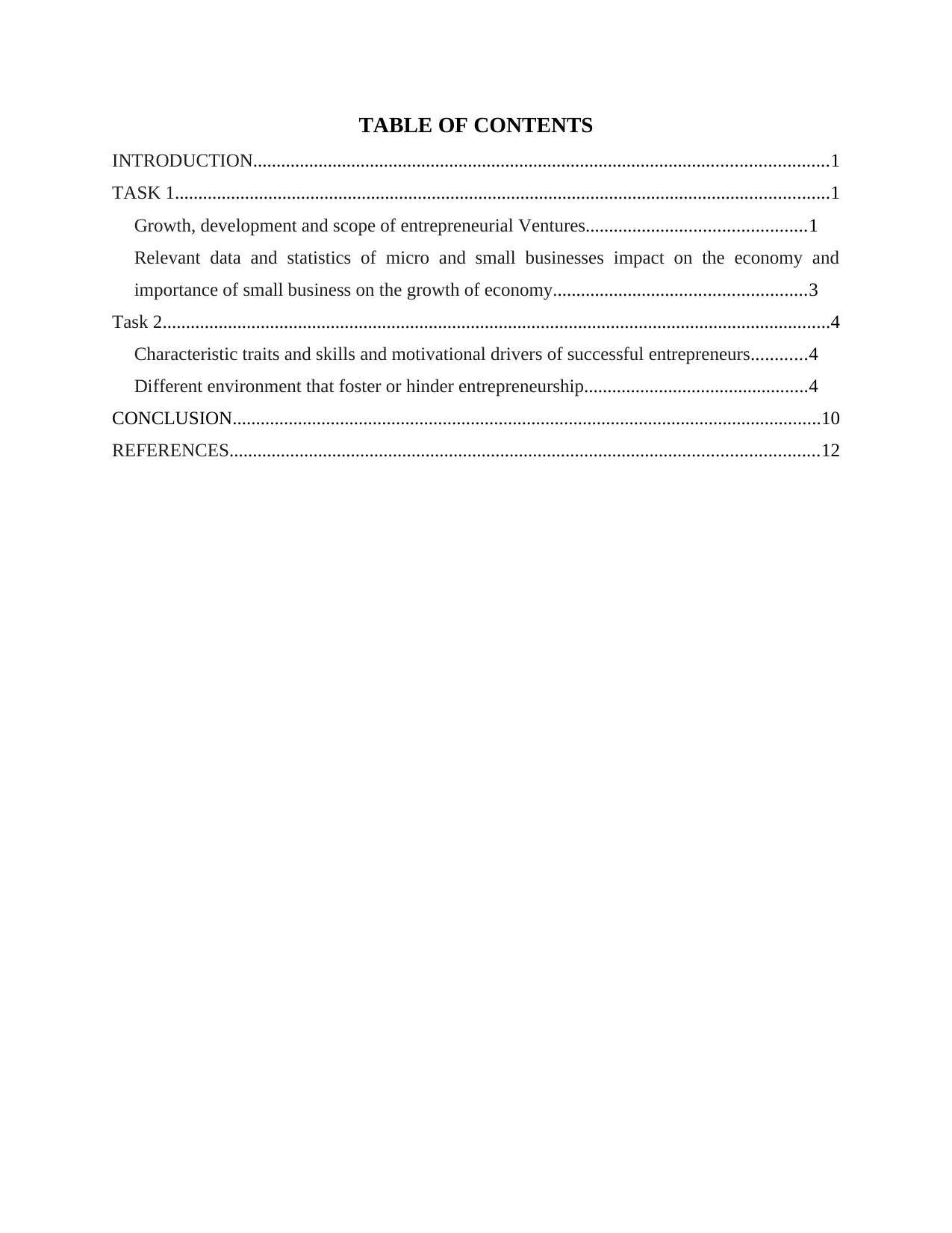
TABLE OF CONTENTS
INTRODUCTION...........................................................................................................................1
TASK 1............................................................................................................................................1
Growth, development and scope of entrepreneurial Ventures...............................................1
Relevant data and statistics of micro and small businesses impact on the economy and
importance of small business on the growth of economy......................................................3
Task 2...............................................................................................................................................4
Characteristic traits and skills and motivational drivers of successful entrepreneurs............4
Different environment that foster or hinder entrepreneurship................................................4
CONCLUSION..............................................................................................................................10
REFERENCES..............................................................................................................................12
INTRODUCTION...........................................................................................................................1
TASK 1............................................................................................................................................1
Growth, development and scope of entrepreneurial Ventures...............................................1
Relevant data and statistics of micro and small businesses impact on the economy and
importance of small business on the growth of economy......................................................3
Task 2...............................................................................................................................................4
Characteristic traits and skills and motivational drivers of successful entrepreneurs............4
Different environment that foster or hinder entrepreneurship................................................4
CONCLUSION..............................................................................................................................10
REFERENCES..............................................................................................................................12
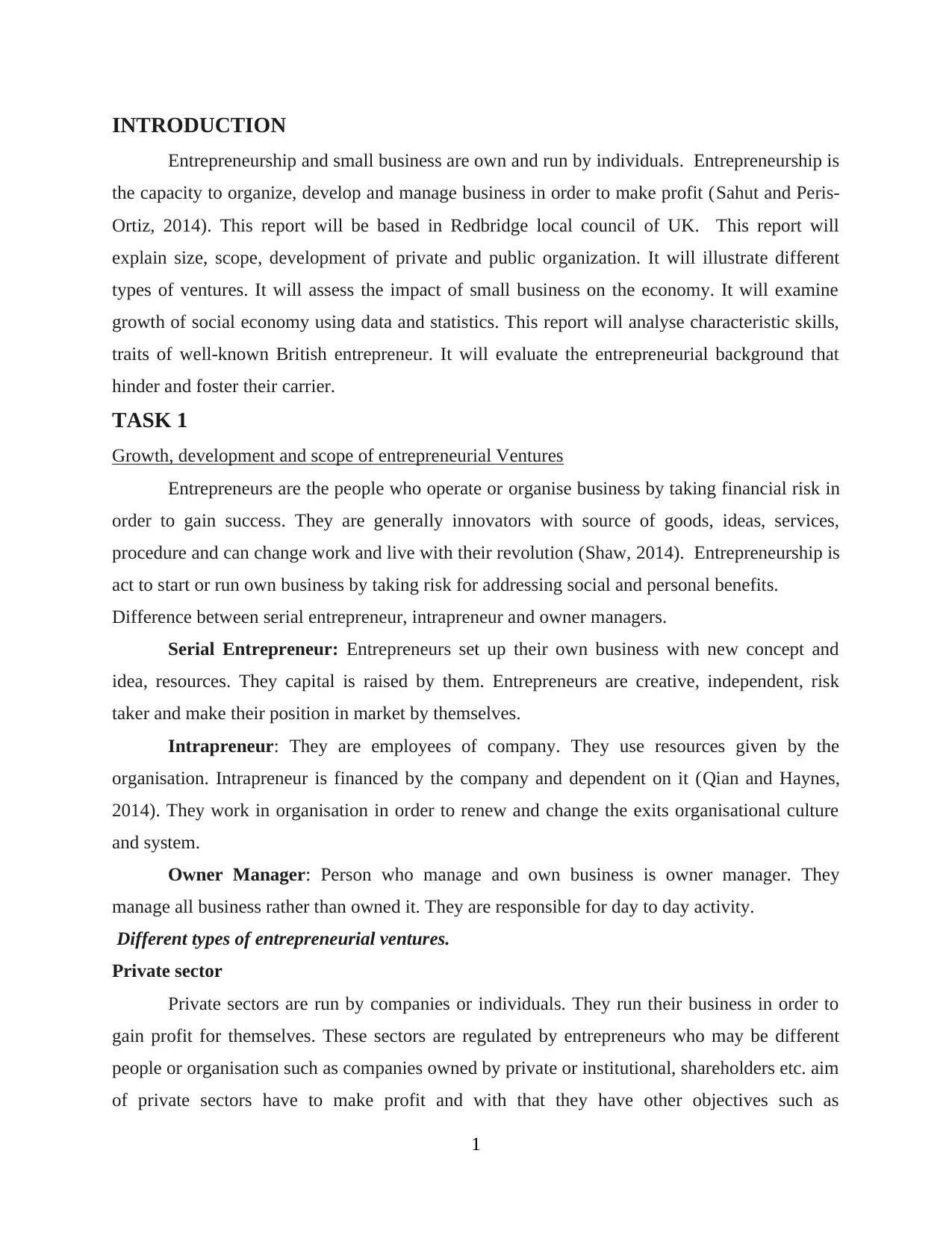
INTRODUCTION
Entrepreneurship and small business are own and run by individuals. Entrepreneurship is
the capacity to organize, develop and manage business in order to make profit (Sahut and Peris-
Ortiz, 2014). This report will be based in Redbridge local council of UK. This report will
explain size, scope, development of private and public organization. It will illustrate different
types of ventures. It will assess the impact of small business on the economy. It will examine
growth of social economy using data and statistics. This report will analyse characteristic skills,
traits of well-known British entrepreneur. It will evaluate the entrepreneurial background that
hinder and foster their carrier.
TASK 1
Growth, development and scope of entrepreneurial Ventures
Entrepreneurs are the people who operate or organise business by taking financial risk in
order to gain success. They are generally innovators with source of goods, ideas, services,
procedure and can change work and live with their revolution (Shaw, 2014). Entrepreneurship is
act to start or run own business by taking risk for addressing social and personal benefits.
Difference between serial entrepreneur, intrapreneur and owner managers.
Serial Entrepreneur: Entrepreneurs set up their own business with new concept and
idea, resources. They capital is raised by them. Entrepreneurs are creative, independent, risk
taker and make their position in market by themselves.
Intrapreneur: They are employees of company. They use resources given by the
organisation. Intrapreneur is financed by the company and dependent on it (Qian and Haynes,
2014). They work in organisation in order to renew and change the exits organisational culture
and system.
Owner Manager: Person who manage and own business is owner manager. They
manage all business rather than owned it. They are responsible for day to day activity.
Different types of entrepreneurial ventures.
Private sector
Private sectors are run by companies or individuals. They run their business in order to
gain profit for themselves. These sectors are regulated by entrepreneurs who may be different
people or organisation such as companies owned by private or institutional, shareholders etc. aim
of private sectors have to make profit and with that they have other objectives such as
1
Entrepreneurship and small business are own and run by individuals. Entrepreneurship is
the capacity to organize, develop and manage business in order to make profit (Sahut and Peris-
Ortiz, 2014). This report will be based in Redbridge local council of UK. This report will
explain size, scope, development of private and public organization. It will illustrate different
types of ventures. It will assess the impact of small business on the economy. It will examine
growth of social economy using data and statistics. This report will analyse characteristic skills,
traits of well-known British entrepreneur. It will evaluate the entrepreneurial background that
hinder and foster their carrier.
TASK 1
Growth, development and scope of entrepreneurial Ventures
Entrepreneurs are the people who operate or organise business by taking financial risk in
order to gain success. They are generally innovators with source of goods, ideas, services,
procedure and can change work and live with their revolution (Shaw, 2014). Entrepreneurship is
act to start or run own business by taking risk for addressing social and personal benefits.
Difference between serial entrepreneur, intrapreneur and owner managers.
Serial Entrepreneur: Entrepreneurs set up their own business with new concept and
idea, resources. They capital is raised by them. Entrepreneurs are creative, independent, risk
taker and make their position in market by themselves.
Intrapreneur: They are employees of company. They use resources given by the
organisation. Intrapreneur is financed by the company and dependent on it (Qian and Haynes,
2014). They work in organisation in order to renew and change the exits organisational culture
and system.
Owner Manager: Person who manage and own business is owner manager. They
manage all business rather than owned it. They are responsible for day to day activity.
Different types of entrepreneurial ventures.
Private sector
Private sectors are run by companies or individuals. They run their business in order to
gain profit for themselves. These sectors are regulated by entrepreneurs who may be different
people or organisation such as companies owned by private or institutional, shareholders etc. aim
of private sectors have to make profit and with that they have other objectives such as
1
⊘ This is a preview!⊘
Do you want full access?
Subscribe today to unlock all pages.

Trusted by 1+ million students worldwide
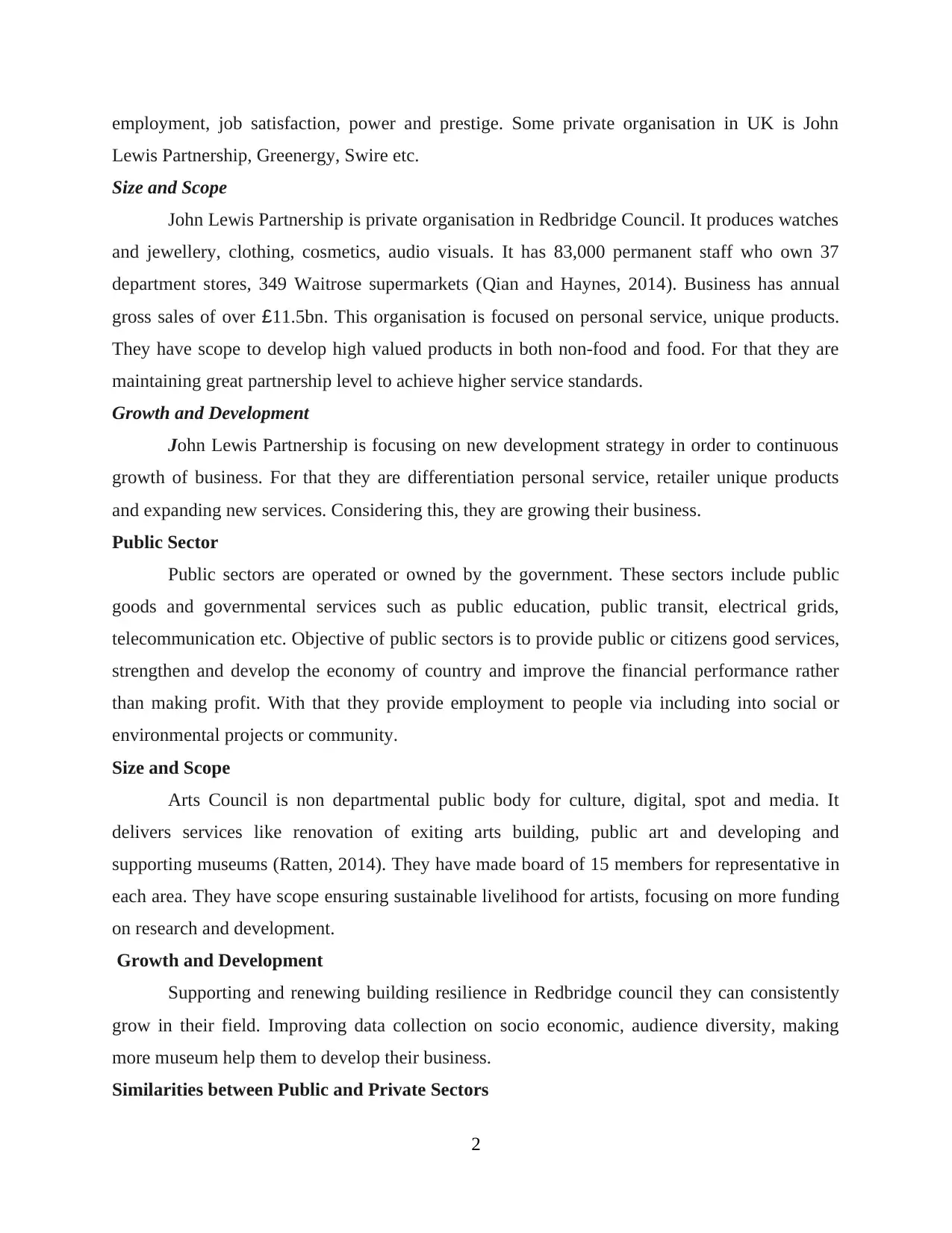
employment, job satisfaction, power and prestige. Some private organisation in UK is John
Lewis Partnership, Greenergy, Swire etc.
Size and Scope
John Lewis Partnership is private organisation in Redbridge Council. It produces watches
and jewellery, clothing, cosmetics, audio visuals. It has 83,000 permanent staff who own 37
department stores, 349 Waitrose supermarkets (Qian and Haynes, 2014). Business has annual
gross sales of over £11.5bn. This organisation is focused on personal service, unique products.
They have scope to develop high valued products in both non-food and food. For that they are
maintaining great partnership level to achieve higher service standards.
Growth and Development
John Lewis Partnership is focusing on new development strategy in order to continuous
growth of business. For that they are differentiation personal service, retailer unique products
and expanding new services. Considering this, they are growing their business.
Public Sector
Public sectors are operated or owned by the government. These sectors include public
goods and governmental services such as public education, public transit, electrical grids,
telecommunication etc. Objective of public sectors is to provide public or citizens good services,
strengthen and develop the economy of country and improve the financial performance rather
than making profit. With that they provide employment to people via including into social or
environmental projects or community.
Size and Scope
Arts Council is non departmental public body for culture, digital, spot and media. It
delivers services like renovation of exiting arts building, public art and developing and
supporting museums (Ratten, 2014). They have made board of 15 members for representative in
each area. They have scope ensuring sustainable livelihood for artists, focusing on more funding
on research and development.
Growth and Development
Supporting and renewing building resilience in Redbridge council they can consistently
grow in their field. Improving data collection on socio economic, audience diversity, making
more museum help them to develop their business.
Similarities between Public and Private Sectors
2
Lewis Partnership, Greenergy, Swire etc.
Size and Scope
John Lewis Partnership is private organisation in Redbridge Council. It produces watches
and jewellery, clothing, cosmetics, audio visuals. It has 83,000 permanent staff who own 37
department stores, 349 Waitrose supermarkets (Qian and Haynes, 2014). Business has annual
gross sales of over £11.5bn. This organisation is focused on personal service, unique products.
They have scope to develop high valued products in both non-food and food. For that they are
maintaining great partnership level to achieve higher service standards.
Growth and Development
John Lewis Partnership is focusing on new development strategy in order to continuous
growth of business. For that they are differentiation personal service, retailer unique products
and expanding new services. Considering this, they are growing their business.
Public Sector
Public sectors are operated or owned by the government. These sectors include public
goods and governmental services such as public education, public transit, electrical grids,
telecommunication etc. Objective of public sectors is to provide public or citizens good services,
strengthen and develop the economy of country and improve the financial performance rather
than making profit. With that they provide employment to people via including into social or
environmental projects or community.
Size and Scope
Arts Council is non departmental public body for culture, digital, spot and media. It
delivers services like renovation of exiting arts building, public art and developing and
supporting museums (Ratten, 2014). They have made board of 15 members for representative in
each area. They have scope ensuring sustainable livelihood for artists, focusing on more funding
on research and development.
Growth and Development
Supporting and renewing building resilience in Redbridge council they can consistently
grow in their field. Improving data collection on socio economic, audience diversity, making
more museum help them to develop their business.
Similarities between Public and Private Sectors
2
Paraphrase This Document
Need a fresh take? Get an instant paraphrase of this document with our AI Paraphraser
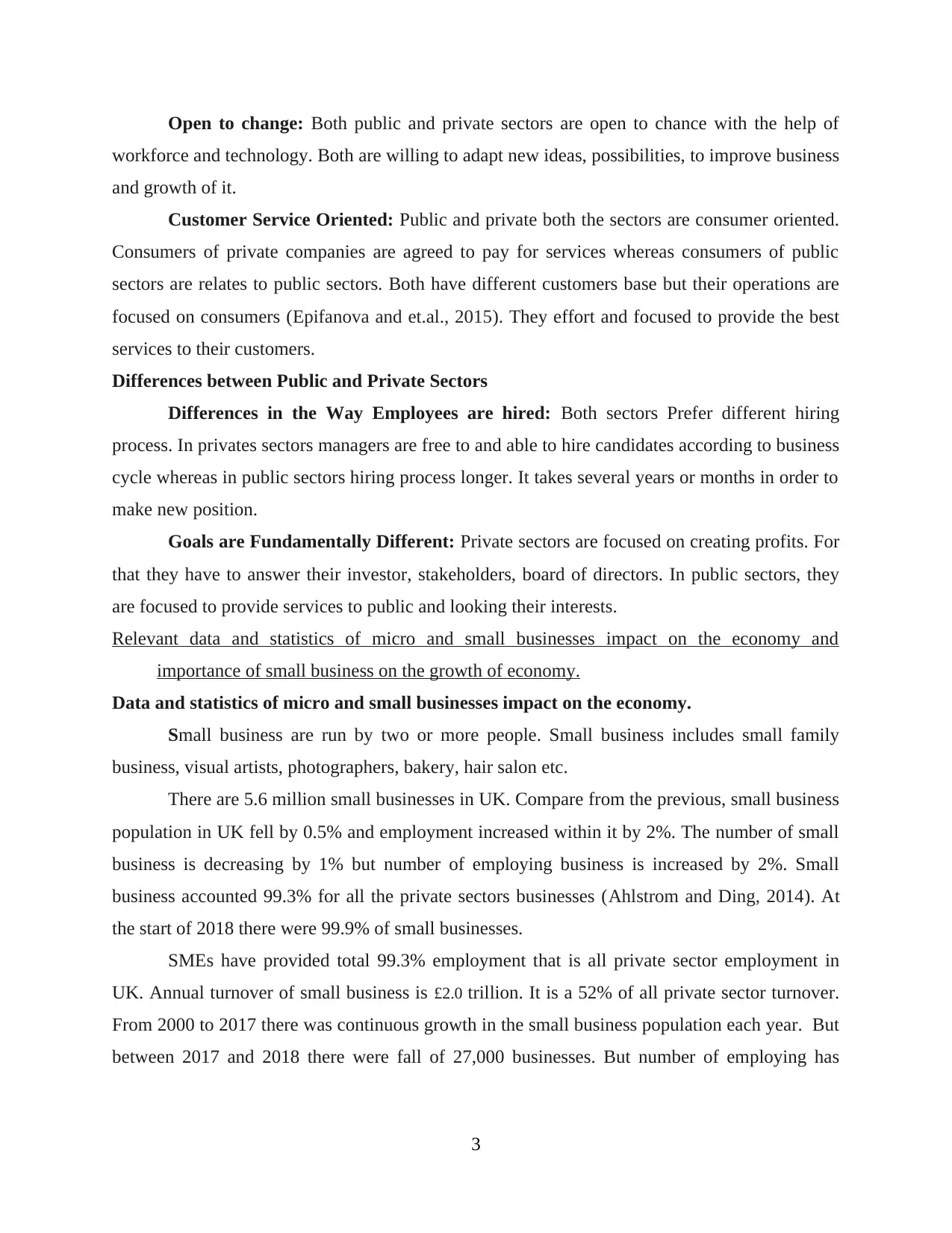
Open to change: Both public and private sectors are open to chance with the help of
workforce and technology. Both are willing to adapt new ideas, possibilities, to improve business
and growth of it.
Customer Service Oriented: Public and private both the sectors are consumer oriented.
Consumers of private companies are agreed to pay for services whereas consumers of public
sectors are relates to public sectors. Both have different customers base but their operations are
focused on consumers (Epifanova and et.al., 2015). They effort and focused to provide the best
services to their customers.
Differences between Public and Private Sectors
Differences in the Way Employees are hired: Both sectors Prefer different hiring
process. In privates sectors managers are free to and able to hire candidates according to business
cycle whereas in public sectors hiring process longer. It takes several years or months in order to
make new position.
Goals are Fundamentally Different: Private sectors are focused on creating profits. For
that they have to answer their investor, stakeholders, board of directors. In public sectors, they
are focused to provide services to public and looking their interests.
Relevant data and statistics of micro and small businesses impact on the economy and
importance of small business on the growth of economy.
Data and statistics of micro and small businesses impact on the economy.
Small business are run by two or more people. Small business includes small family
business, visual artists, photographers, bakery, hair salon etc.
There are 5.6 million small businesses in UK. Compare from the previous, small business
population in UK fell by 0.5% and employment increased within it by 2%. The number of small
business is decreasing by 1% but number of employing business is increased by 2%. Small
business accounted 99.3% for all the private sectors businesses (Ahlstrom and Ding, 2014). At
the start of 2018 there were 99.9% of small businesses.
SMEs have provided total 99.3% employment that is all private sector employment in
UK. Annual turnover of small business is £2.0 trillion. It is a 52% of all private sector turnover.
From 2000 to 2017 there was continuous growth in the small business population each year. But
between 2017 and 2018 there were fall of 27,000 businesses. But number of employing has
3
workforce and technology. Both are willing to adapt new ideas, possibilities, to improve business
and growth of it.
Customer Service Oriented: Public and private both the sectors are consumer oriented.
Consumers of private companies are agreed to pay for services whereas consumers of public
sectors are relates to public sectors. Both have different customers base but their operations are
focused on consumers (Epifanova and et.al., 2015). They effort and focused to provide the best
services to their customers.
Differences between Public and Private Sectors
Differences in the Way Employees are hired: Both sectors Prefer different hiring
process. In privates sectors managers are free to and able to hire candidates according to business
cycle whereas in public sectors hiring process longer. It takes several years or months in order to
make new position.
Goals are Fundamentally Different: Private sectors are focused on creating profits. For
that they have to answer their investor, stakeholders, board of directors. In public sectors, they
are focused to provide services to public and looking their interests.
Relevant data and statistics of micro and small businesses impact on the economy and
importance of small business on the growth of economy.
Data and statistics of micro and small businesses impact on the economy.
Small business are run by two or more people. Small business includes small family
business, visual artists, photographers, bakery, hair salon etc.
There are 5.6 million small businesses in UK. Compare from the previous, small business
population in UK fell by 0.5% and employment increased within it by 2%. The number of small
business is decreasing by 1% but number of employing business is increased by 2%. Small
business accounted 99.3% for all the private sectors businesses (Ahlstrom and Ding, 2014). At
the start of 2018 there were 99.9% of small businesses.
SMEs have provided total 99.3% employment that is all private sector employment in
UK. Annual turnover of small business is £2.0 trillion. It is a 52% of all private sector turnover.
From 2000 to 2017 there was continuous growth in the small business population each year. But
between 2017 and 2018 there were fall of 27,000 businesses. But number of employing has
3

increased by 23,000 and non-employing business has fell by 50,000 between 2107 and 2018 and
result of this 27,000 businesses has decreased.
Number of ordinary partnership and sole proprietorship has decreased by 49,000 and
9,000 respectively, whereas bomber of companies has increased last year by 31,000.
Importance of Small businesses on the growth of economy
Small businesses play an important role on the growth of UK economy. They are able to
provide local consumers such as hairdresser, salon, financial consultant and many more. With
that small business provide employment at local and regional level. Small businesses influenced
economy growth such as local regional and national level.
Local level: Small business make a big impact on local economy. They provide them
chance to share their innovation, ideas to establish business. It delivers the employment
opportunity to local residence. Small businesses contribute to local economy by making
innovation to the community (Ahlstrom and Ding, 2014). It thrives local economy by generating
high level of revenue. This economy then use in local police, schools and fire department. It
improves property values with that improves bottom line of homeowners.
Regional Level: it plays an essential role in regional economy, because it has 90% of
business and provide employment over 50%. This business uses local resources and their profit
stay in the region. The number of small businesses in UK is growing over time. This
development increases the revenue to UK economy.
National economy: small business have verity of background. It pursues the employment
at national level. In some past years, small businesses have registered big growth rate. The
largest industry in UK are retail, manufacturing and the repair of motor vehicles like Henry
Ford's company, and small businesses are at the heart of these three core economic activities.
(Toma, Grigore and Marinescu, 2014) Many small and medium business revenue comes from
businesses in one of these sectors.
Task 2
Characteristic traits and skills and motivational drivers of successful entrepreneurs
Covered in ppt
Different environment that foster or hinder entrepreneurship
Covered in ppt
4
result of this 27,000 businesses has decreased.
Number of ordinary partnership and sole proprietorship has decreased by 49,000 and
9,000 respectively, whereas bomber of companies has increased last year by 31,000.
Importance of Small businesses on the growth of economy
Small businesses play an important role on the growth of UK economy. They are able to
provide local consumers such as hairdresser, salon, financial consultant and many more. With
that small business provide employment at local and regional level. Small businesses influenced
economy growth such as local regional and national level.
Local level: Small business make a big impact on local economy. They provide them
chance to share their innovation, ideas to establish business. It delivers the employment
opportunity to local residence. Small businesses contribute to local economy by making
innovation to the community (Ahlstrom and Ding, 2014). It thrives local economy by generating
high level of revenue. This economy then use in local police, schools and fire department. It
improves property values with that improves bottom line of homeowners.
Regional Level: it plays an essential role in regional economy, because it has 90% of
business and provide employment over 50%. This business uses local resources and their profit
stay in the region. The number of small businesses in UK is growing over time. This
development increases the revenue to UK economy.
National economy: small business have verity of background. It pursues the employment
at national level. In some past years, small businesses have registered big growth rate. The
largest industry in UK are retail, manufacturing and the repair of motor vehicles like Henry
Ford's company, and small businesses are at the heart of these three core economic activities.
(Toma, Grigore and Marinescu, 2014) Many small and medium business revenue comes from
businesses in one of these sectors.
Task 2
Characteristic traits and skills and motivational drivers of successful entrepreneurs
Covered in ppt
Different environment that foster or hinder entrepreneurship
Covered in ppt
4
⊘ This is a preview!⊘
Do you want full access?
Subscribe today to unlock all pages.

Trusted by 1+ million students worldwide
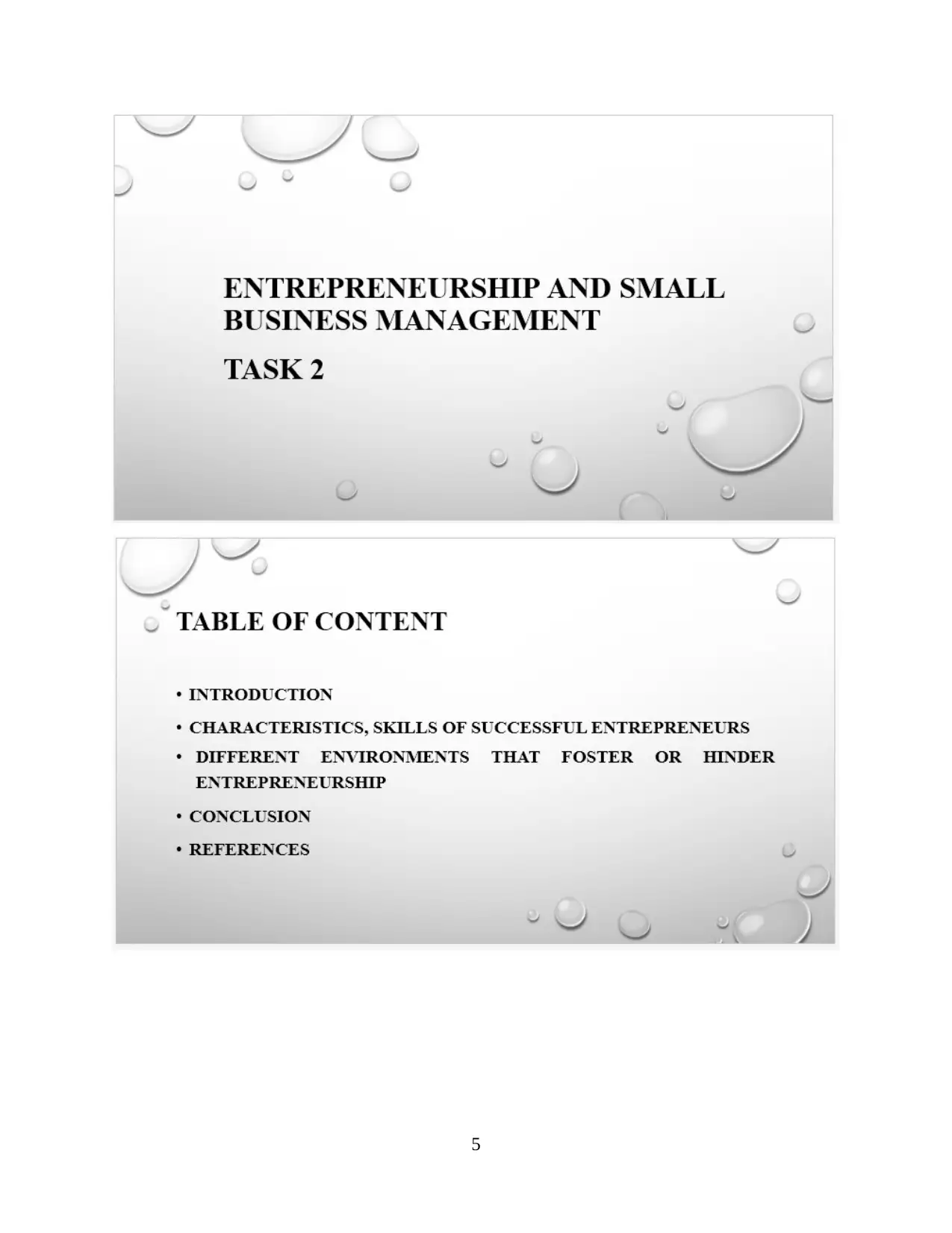
5
Paraphrase This Document
Need a fresh take? Get an instant paraphrase of this document with our AI Paraphraser

6

7
⊘ This is a preview!⊘
Do you want full access?
Subscribe today to unlock all pages.

Trusted by 1+ million students worldwide

8
Paraphrase This Document
Need a fresh take? Get an instant paraphrase of this document with our AI Paraphraser

9
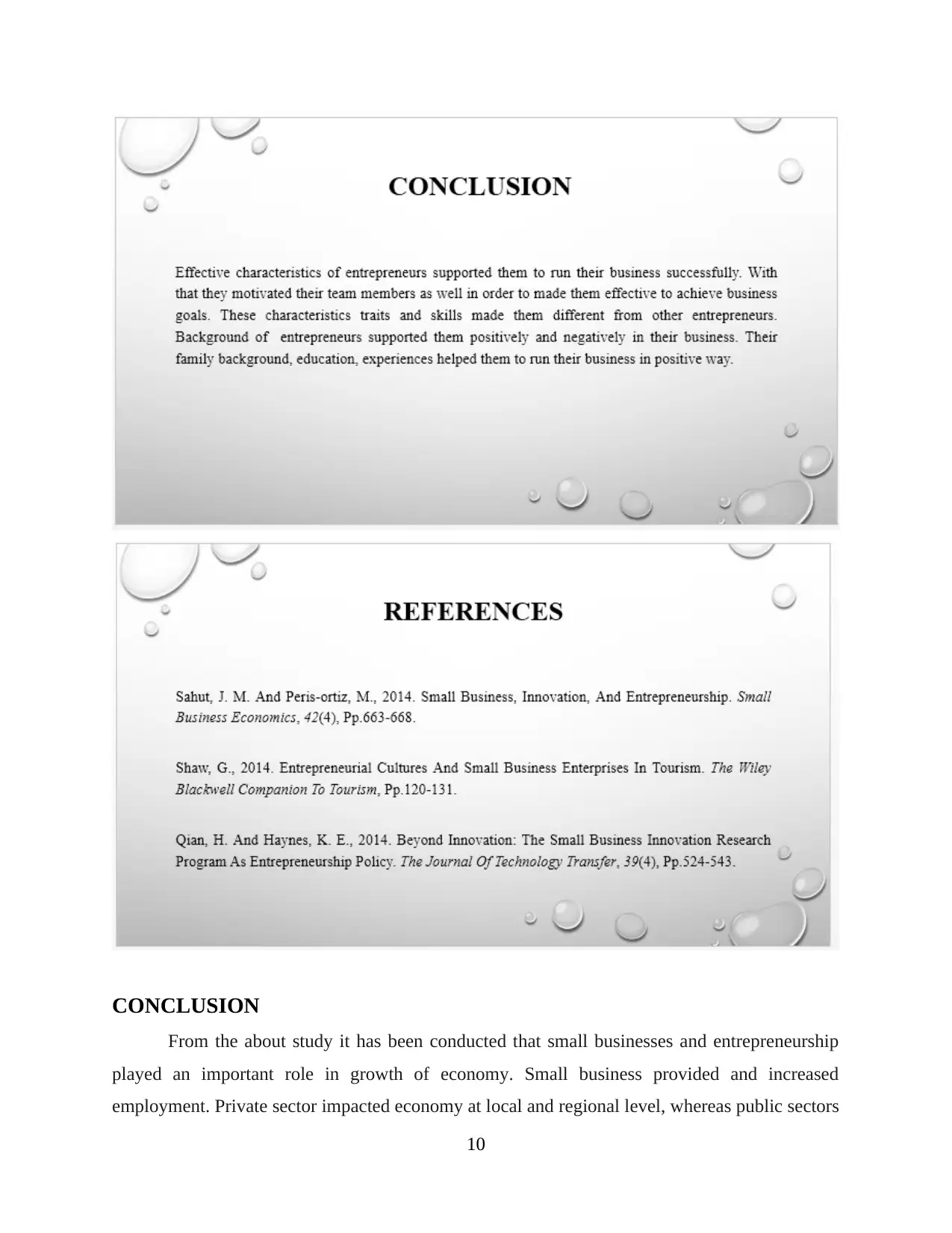
CONCLUSION
From the about study it has been conducted that small businesses and entrepreneurship
played an important role in growth of economy. Small business provided and increased
employment. Private sector impacted economy at local and regional level, whereas public sectors
10
From the about study it has been conducted that small businesses and entrepreneurship
played an important role in growth of economy. Small business provided and increased
employment. Private sector impacted economy at local and regional level, whereas public sectors
10
⊘ This is a preview!⊘
Do you want full access?
Subscribe today to unlock all pages.

Trusted by 1+ million students worldwide
1 out of 14
Related Documents
Your All-in-One AI-Powered Toolkit for Academic Success.
+13062052269
info@desklib.com
Available 24*7 on WhatsApp / Email
![[object Object]](/_next/static/media/star-bottom.7253800d.svg)
Unlock your academic potential
Copyright © 2020–2025 A2Z Services. All Rights Reserved. Developed and managed by ZUCOL.





